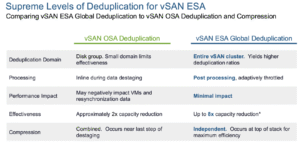
VMware Cloud Foundation (VCF) 9.0 introduces a comprehensive suite of storage enhancements that significantly improve performance, scalability, and operational efficiency. At the heart of these improvements is VMware vSAN 9.0, which powers the storage layer of VCF and brings advanced capabilities such as global deduplication, enhanced monitoring, and multi-site operations.
One of the standout features in VCF 9.0 is the introduction of global deduplication in vSAN Express Storage Architecture (ESA). This feature allows for cluster-wide deduplication, optimizing storage efficiency across the entire vSAN cluster. This is in contrast to the deduplication capabilities of the Original Storage Architecture (OSA), which could only reduce data within a single disk group and was isolated to a single server.
Unlike traditional array-based deduplication, which is limited by the scope of individual arrays, vSAN ESA’s global deduplication scales with the cluster, offering up to 8x capacity reduction. This is achieved through post-processing deduplication that is adaptively throttled to minimize performance impact. The deduplication process includes secure cryptographic hashing and smart-sharding to maintain performance and reduce fragmentation.
While VMware has noted that global dedupe is available with RPQ (Request for Product Qualification) in 9.0, it is a production-ready feature that they are prepared to support for all environments. As this is a major new feature however, there is a desire to have visibility and consultation into customer implementations for quality assurance as it is introduced.
VCF 9.0 also enhances storage visibility and monitoring through new dashboards integrated into the VCF Operations console. These dashboards provide holistic views of storage operations, vSAN performance, and diagnostics, enabling administrators to quickly assess the health and performance of their storage infrastructure. Key metrics are retrieved directly from vSAN APIs, ensuring accurate and real-time insights.
Another critical advancement is the support for multi-site operations. VCF 9.0 enables vSAN-to-vSAN replication, allowing for agile and high-performance per-VM replication to remote clusters. This is particularly beneficial for disaster recovery and long-term data retention. The VMware Live Recovery (VLR) add-on facilitates policy-based protection groups and site pairing, enabling seamless failover and failback operations.
The platform also supports a wide range of vSAN deployment types, including single-site clusters, disaggregated storage clusters, stretched clusters, and 2-node clusters. This flexibility allows organizations to transition existing vSAN deployments into VCF with ease. The import process converts the first vCenter server and cluster into a management domain and integrates additional clusters into workload domains.
Network traffic optimization is another area where VCF 9.0 excels. By isolating vSAN cluster traffic from vSphere client clusters, the platform reduces network congestion and improves performance. Dedicated VMkernel interfaces are used for vSAN and client traffic, and compression is applied to traffic between client clusters and the vSAN storage cluster. This separation simplifies management and enhances security.
VCF 9.0 also introduces improvements in vSAN File Services, doubling the number of supported file shares per cluster to 500. This is particularly useful for cloud-native workloads, guest VMs, and legacy physical servers requiring NFS or SMB shares. The platform supports up to 100 SMB shares per cluster, providing ample flexibility for diverse use cases.
Security and resilience are further bolstered through enhanced support for stretched clusters. VCF 9.0 allows for site-wide maintenance mode and manual site takeover, ensuring data availability even during severe outages. These features are accessible via both UI and API, streamlining operations and reducing the risk of human error.
From a cost perspective, VCF 9.0 leverages the declining prices of TLC NVMe drives to offer a more economical storage solution. The platform’s ability to manage and protect workloads at the VM level provides unprecedented control and visibility, making it a compelling choice for modern data centers.
Existing vSAN customers who wish to adopt VCF 9.0 and the new feature enhancements it brings to vSAN can expect a familiar transition process. Once the vCenter server managing a cluster is upgraded to 9.0 as part of a VCF deployment, upgrade and import of existing clusters is an automated and non-disruptive process. While this process is likely to be run in a maintenance window to avoid any potential risks, it is expected to work similarly to previous vSAN migration and upgrade procedures.
Not only does VCF import make it possible to integrate existing vSAN clusters non-disruptively, it allows IT admins to bring the management-at-scale capabilities of VCF Operations to bear on what could previously have been multiple disparate infrastructure silos. As a result, IT admins can ensure that consistent configuration and operations are brought to their vSAN clusters as a part of their VCF fleet.
In conclusion, VMware Cloud Foundation 9.0 represents a significant leap forward in storage technology. With its robust feature set, including global deduplication, enhanced monitoring, multi-site replication, and improved scalability, VCF 9.0 is well-equipped to meet the demands of today’s dynamic IT environments. Organizations looking to optimize their storage infrastructure will find VCF 9.0 to be a powerful and flexible solution.
The VMware Cloud Foundation 9.0 Showcase: Powering the Modern Private Cloud was presented by VMware in association with Techstrong and Tech Field Day. The videos will be posted to the Tech Field Day YouTube channel and on the website. You can learn more about VMware Cloud Foundation 9.0 on the VMware website.



